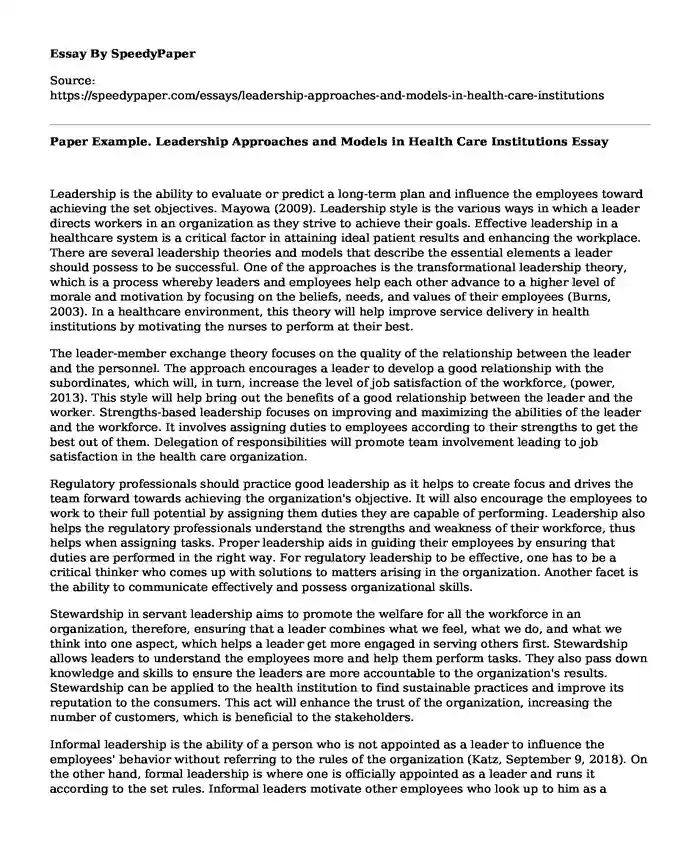
| Type of paper: | Essay |
| Categories: | Leadership analysis Goal Medicine |
| Pages: | 3 |
| Wordcount: | 700 words |
Leadership is the ability to evaluate or predict a long-term plan and influence the employees toward achieving the set objectives. Mayowa (2009). Leadership style is the various ways in which a leader directs workers in an organization as they strive to achieve their goals. Effective leadership in a healthcare system is a critical factor in attaining ideal patient results and enhancing the workplace. There are several leadership theories and models that describe the essential elements a leader should possess to be successful. One of the approaches is the transformational leadership theory, which is a process whereby leaders and employees help each other advance to a higher level of morale and motivation by focusing on the beliefs, needs, and values of their employees (Burns, 2003). In a healthcare environment, this theory will help improve service delivery in health institutions by motivating the nurses to perform at their best.
The leader-member exchange theory focuses on the quality of the relationship between the leader and the personnel. The approach encourages a leader to develop a good relationship with the subordinates, which will, in turn, increase the level of job satisfaction of the workforce, (power, 2013). This style will help bring out the benefits of a good relationship between the leader and the worker. Strengths-based leadership focuses on improving and maximizing the abilities of the leader and the workforce. It involves assigning duties to employees according to their strengths to get the best out of them. Delegation of responsibilities will promote team involvement leading to job satisfaction in the health care organization.
Regulatory professionals should practice good leadership as it helps to create focus and drives the team forward towards achieving the organization's objective. It will also encourage the employees to work to their full potential by assigning them duties they are capable of performing. Leadership also helps the regulatory professionals understand the strengths and weakness of their workforce, thus helps when assigning tasks. Proper leadership aids in guiding their employees by ensuring that duties are performed in the right way. For regulatory leadership to be effective, one has to be a critical thinker who comes up with solutions to matters arising in the organization. Another facet is the ability to communicate effectively and possess organizational skills.
Stewardship in servant leadership aims to promote the welfare for all the workforce in an organization, therefore, ensuring that a leader combines what we feel, what we do, and what we think into one aspect, which helps a leader get more engaged in serving others first. Stewardship allows leaders to understand the employees more and help them perform tasks. They also pass down knowledge and skills to ensure the leaders are more accountable to the organization's results. Stewardship can be applied to the health institution to find sustainable practices and improve its reputation to the consumers. This act will enhance the trust of the organization, increasing the number of customers, which is beneficial to the stakeholders.
Informal leadership is the ability of a person who is not appointed as a leader to influence the employees' behavior without referring to the rules of the organization (Katz, September 9, 2018). On the other hand, formal leadership is where one is officially appointed as a leader and runs it according to the set rules. Informal leaders motivate other employees who look up to him as a leader. Informal leadership in health institutions builds a consensus within the workforce, which is vital to the facility's long-term well-being.
Adaptive leadership theory encourages teamwork between the leader and the personnel. In this theory, the leader combines effort with the employees and come up with the solution to a particular task. Leaders in a health care organization can adopt this theory and enhance the health institution's performance by joining forces to solve the issues in the organization. Teamwork is an important factor in this theory, as it helps find solutions to problems.
References
Adeoye Mayowa: A Leadership Manager in Nigeria (2009). https://alisajjad3.wordpress.com/2015/04/30/leadership-styles-and-management-theories/
Hary katz. (Septmber 9, 2018). Informal leadership: leading without authority. Medium. https://medium.com/@harry_katz/informal-leadership-leading-without-authority-6373ff4e0a51
MacGregor Burns, J. (2003). Transforming leadership. New York, NY: Atlantic Monthly. https://en.wikipedia.org/w/index.php?title=James_MacGregor_Burns
Power, R. L. (2013). Leader-member exchange theory in higher and distance education. International Review of Research in Open and Distributed Learning, 14(4), 277-284. http://www.irrodl.org/index.php/irrodl/article/view/1582/2631
Cite this page
Paper Example. Leadership Approaches and Models in Health Care Institutions. (2023, Oct 03). Retrieved from https://speedypaper.com/essays/leadership-approaches-and-models-in-health-care-institutions
Request Removal
If you are the original author of this essay and no longer wish to have it published on the SpeedyPaper website, please click below to request its removal:
- Transdev Company - Contract Management Essay Example
- Diastolic Heart Failure: Diagnosis and Treatment
- Free Essay with a Critical Analysis of Mr. P's Case Study
- Essay Sample on Maternity Case Study
- Free Essay Example - Alcohol Abuse Intervention Program
- Laws & Regulations Impacting Healthcare Orgs: A Comprehensive Guide - Essay Sample
- Essay Sample on Factors Causing Maldistribution
Popular categories




